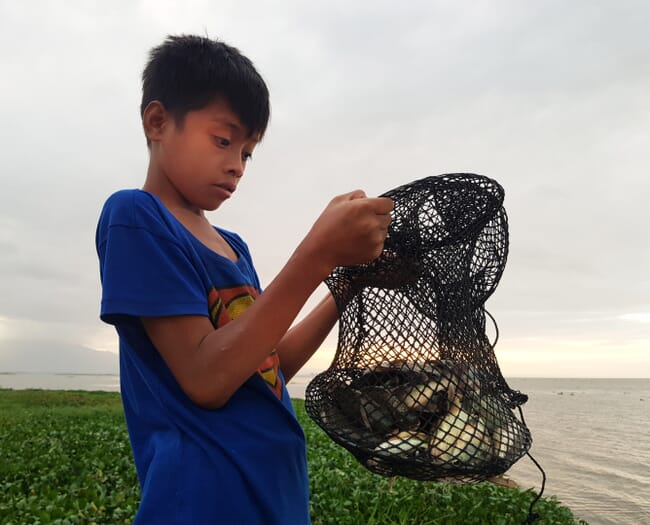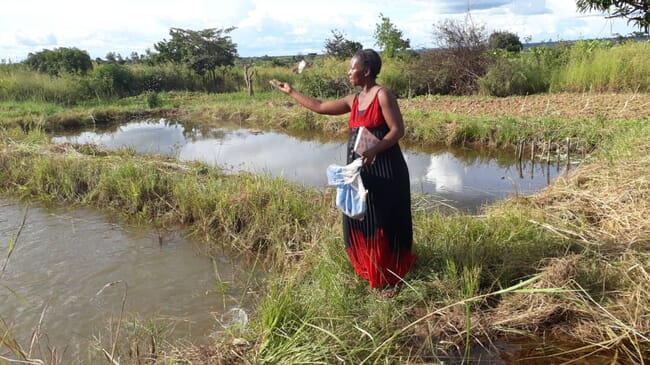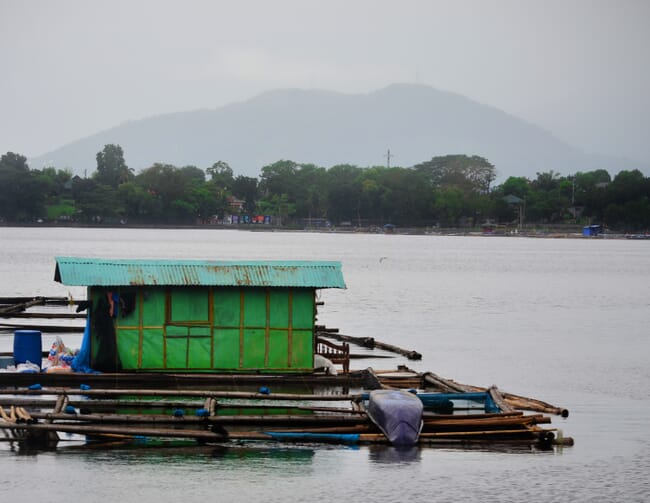The aquaculture sector continues to grow rapidly across the globe – but its environmental impacts are growing as well. From farmed salmon displacing indigenous salmon and other fish to tonnes of aquaculture sludge quietly blanketing and degrading coral reefs and other natural habitats, old-school aquaculture has become a boom-and-bust venture.
Fortunately, many of today’s forward-looking aquaculture operators have the technology, the knowhow and the heart to take increasing responsibility for reducing the environmental impacts of their businesses.

© Gregg Yan
Globally, most aquaculture operations take place in Southeast Asia, often using small ponds or cage systems managed by smallholder families or local companies. Aquaculture in Africa is similar, though not yet as intensive. Both Africa and Southeast Asia are characterised by their incredible levels of biodiversity and unique biomes – making it doubly important to limit the impacts of local aquaculture activities.
This month, we interview Kyra Hoevenaars, who heads the consulting department at the AquaBioTech Group. She is an expert in sustainable aquaculture and recently worked on a training programme on good aquaculture practices for the ASEAN region and WorldFish. Along with Jonas Wiza Ng’ambi, Hoevenaars also recently authored a guide, Better management practices manual for smallholders farming tilapia in pond-based systems in Zambia, for CGIAR, an initiative led by WorldFish.
Together they offer six tips which have not only helped to improve the environmental sustainability of numerous aquaculture operations, but have also been shown – perhaps more surprisingly – to improve their financial performance too, creating a win-win situation for both people and nature.
1. Choose the right species
As discussed in one of our recent articles on invasive species, invasive non-native species (INNS) are plants and animals which do not naturally occur in a specific location and can spread quickly enough to rob native species of resources. These can eventually overtake and replace native species, or hybridise with them.
This has already happened in many countries, with fish such as the highly adaptable tilapia displacing native freshwater species across the tropics. In colder climates, non-native salmon have repeatedly escaped their pens and are displacing native salmon populations. One of the few comprehensive studies on this indicates that, in the United States alone, escaped exotic fish cause almost $5.4 billion in economic losses each year. Investigations in other regions paint similar pictures.

© Kyra Hoevenaars
On the other hand, native species often perform better, having developed traits and habits best-suited to local ecosystems. Local demand is often higher as people from a specific region prefer familiar and traditionally consumed species. This gives farmers the opportunity to fetch higher prices and a very real incentive to choose native species over exotic ones. As Hoevenaars explains: “In Zambia, the Fisheries Act states that tilapia species can only be cultured if this species is present in receiving waters only. In the BMP [best management practices] manual, we took this a step further and recommend that farmers stock only native species.”
2. Select a suitable farm site
When selecting a good site for a new farm, environmentally sensitive areas like swamps, coral reefs or mangrove forest should be avoided. Establishing a farm would have severe consequences on local biodiversity if, for example, mangrove forests or wetlands were cleared and converted into fish ponds. Farm effluents would also eventually have a considerable negative impact. Excessive nutrients via the influx of farm effluents would result in eutrophication, making waters murky, blotting out sunlight and negatively affecting the growth of plants, corals and the area’s other denizens.
Another benefit of avoiding these areas is that swamps are highly prone to flooding and coastal mangrove areas are infested with mosquitoes – a serious health risk for farm workers.
“Looking at the example of Zambia, many farms are located in so called ‘dambo’ areas, which are located in low-lying swamps, often below flood level. Here ponds are not drainable since water continuously flows in from underground. These areas are very prone to flooding, so these are not ideal sites for fish farming,” Hoevenaars explains.
When selecting sites for marine cages, unless you have the capital available to buy top-of-the-range equipment, any area that is exposed and vulnerable to big storms should be avoided since storms can repeatedly batter and destroy expensive and hard-to-repair pens and cages. Instead, a sheltered area that is protected from high waves should be selected.

© Gregg Yan
3. Farm design and layout
Most traditional fish farms, especially pond farms, directly release their untreated wastewater into the environment surrounding their farms. This is a serious concern, not just for the natural environment, but also for surrounding communities which often use the water from public canals for drinking, bathing and washing utensils. Neighbouring fish farms are also threatened, as potential pathogens will spread swiftly and easily this way.
It is thus beneficial to design pond operations which treat and reuse this water. This can be done by allocating several extra ponds for water treatment. For example, a settling pond allows solids to collect at the pond bed. Filter feeders like bivalves or plants like mangroves can then clean the water, while wood chips can remove excess nitrates. Finally, chemicals can then be added to kill off pathogens if needed. Discharged wastewater should go through a similar treatment before disposal.
Another solution which can be integrated into the previous recommendation is to use a biofloc system where waste materials like uneaten feeds and faeces are converted to feed fish and shrimp, thereby reducing waste output while driving down feed costs and enhancing farm productivity by up to 20 percent.
Besides improving environmental sustainability, embracing these practices reduces water usage and minimises the potential spread of pathogens, as the biosecurity of the farm is improved. Fewer disease outbreaks hugely improve the financial performance of farms. Careful planning and proper farm design will pay long-term dividends for both farmers and the environment.
4. Manage feeding practices
Feeds contribute the largest share of waste in and around fish farms. When using trash fish or low-quality pellets, a great deal of feeds will be ignored by the fish. These will sink to the bottom, causing the water quality to deteriorate. When released, these effluents also degrade the water quality of the surrounding area.
Similarly, when using low-grade feed pellets with excessively high protein content, high levels of unused nutrients end up in the faeces of the fish, which pollutes the water they live in. It is thus recommended to use only high-quality pellets specifically designed for your chosen fish species. Besides creating less pollution, high-quality food results in better growth rates and improved health, again increasing farm performance. Remember that when it comes to fish feeding, trash in means trash out.
According to Hoevenaars, a lot of small-scale farmers in Africa and Asia still use single ingredients such as rice bran or even kitchen waste to feed their fish. Fortunately, in Zambia, there are efforts to distribute quality pellet feeds to these farmers, and the governments of countries in Southeast Asia are providing training in good aquaculture practices to encourage the use of quality pellet feeds in the sector.
Feeding practices play an equally crucial role in reducing pollution. Farmers often overfeed their stock to try to ensure they grow well, but usually only end up wasting money and polluting culture water.
All this weakens the immune systems of farmed fish, increasing mortalities or reducing growth rates. By sticking with good feeding practices, excessive waste can be avoided, while water quality plus the health of farmed fish can be optimised.

© Kyra Hoevenaars
5. Minimise chemicals and veterinary drugs
Many farmers use chemicals for pond preparation – eradicating predators and snails – and to maintain water-quality parameters. Veterinary drugs are sometimes used to keep fish healthy or to treat ailing batches.
The reality is that most of these chemicals end up in the culture water. When farm effluents are released, these potentially deadly chemicals and veterinary drugs can end up in the natural environment surrounding the farm. Think about it: if they were designed to kill snails and pests in ponds, then they will obviously do the same in streams and lakes.
With the right farm knowledge and the use readily available natural alternatives, many of these chemical treatments become unnecessary. Furthermore, when treating sick fish, it is far better to conduct treatments in a separate, quarantined environment where chemicals are not released into the natural environment.
“The guide for smallholders in Zambia recommends the following measures to keep fish healthy and thereby reduce the need for veterinary medicines: stock healthy seed, use clean water, avoid stress (appropriate stocking densities, regular feeding and careful handling) and ensure regular sampling and observations to check for signs of diseases,” explains Hoevenaars.
6. Plant native vegetation
Finally, planting trees around your farm is always a good idea. Trees provide shade, reduce the impacts of wind and can provide an extra source of food for people, fish, birds and other animals.
However it should also be noted that for biosecurity purposes the pond and directly adjacent areas should be kept clear of vegetation, as aquatic weeds provide shelter for vectors and predators and since weeds on the pond dykes and dense vegetation near the pond will be hiding places for predators and other animals.
Remember that when planting trees or other vegetation, you should try to use local species or strains that are native to your area. These will be greatly appreciated by native and migratory birds, plus local bats, insects and other lifeforms which can enhance your area’s biodiversity and productivity. An old adage goes that the best time to plant a tree was yesterday, but the next best time is today.
Conclusions
Through these six tips, we hope to help today’s generation of forward-thinking fish farmers produce more seafood sustainably. Knowing you’re doing your part to alleviate food security while protecting the environment? Now that’s good for both the gut and the heart.
Further information
The guide, Better management practices manual for smallholders farming tilapia in pond-based systems in Zambia, can be downloaded for free here.


